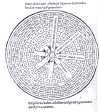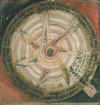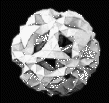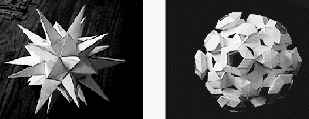|
Historic Paper Devices
Paper dials have been used for
centuries as tools to illustrate complex principles. In the 13th Century, Ramon
Llull of Majorca used several paper
instruments in his manuscript to support and to advocate his missionary arguments.
Llull designed his inventive dials--essentially paper machines--to illustrate religious truths
objectively.
(Source: What Was Llull Up To?, Anthony Bonner, http://www.geocities.com/Athens/Forum/5284/compbon.html)
Moveable
dials called volvelles appeared in printed text as early as 1476, when Johannes
Müller von Königsberg, also known as Regiomontanus,
included four paper
devices with his astronomical calendars.
 Moveable
dials appeared as volvelles
in woodcut, such as this one created by Pacificus Maximus of Florence in 1485. Moveable
dials appeared as volvelles
in woodcut, such as this one created by Pacificus Maximus of Florence in 1485.
Image courtesy of University of Brighton, U.K.; used with permission.
 Volvelles
such as this 15th Century version were designed to aid in the calculation of the
locations of the planets throughout the year. The Planet
Pointer II activity from the Paper Plate Education collection performs a similar function. Volvelles
such as this 15th Century version were designed to aid in the calculation of the
locations of the planets throughout the year. The Planet
Pointer II activity from the Paper Plate Education collection performs a similar function.
Image courtesy of Chetham's Library, U.K.; used with permission.
 Instrument-maker Gemma
Frisius devised a fourth volvelle
for inclusion in Peter Apianus' ambitious 1524 undertaking, Cosmographia, helping
to propel the
book to the 16th Century
equivalent of a bestseller, being printed in at least forty-five editions in four
languages. The Moon Finder
dial from the Paper Plate Education activities performs a
similar function. (View translated text on
the backside of volvelle page.) Instrument-maker Gemma
Frisius devised a fourth volvelle
for inclusion in Peter Apianus' ambitious 1524 undertaking, Cosmographia, helping
to propel the
book to the 16th Century
equivalent of a bestseller, being printed in at least forty-five editions in four
languages. The Moon Finder
dial from the Paper Plate Education activities performs a
similar function. (View translated text on
the backside of volvelle page.)
(Source: A Student Virtual Exhibition at the Museum of the History
of Science, Oxford, http://www.mhs.ox.ac.uk/students/98to99/)
 "On
the evening of November 8, 1895, Wilhelm Roentgen found that, if the
discharge tube is enclosed in a sealed, thick black carton to exclude all
light, and if he worked in a dark room, a paper plate covered on one side
with barium platinocyanide placed in the path of the rays became
fluorescent even when it was as far as two metres from the discharge
tube." Roentgen went on to discover X-rays, with the first
image being of his wife's hand with a ring on it. (Okay, so it was a
different kind of paper plate. Just having fun...) "On
the evening of November 8, 1895, Wilhelm Roentgen found that, if the
discharge tube is enclosed in a sealed, thick black carton to exclude all
light, and if he worked in a dark room, a paper plate covered on one side
with barium platinocyanide placed in the path of the rays became
fluorescent even when it was as far as two metres from the discharge
tube." Roentgen went on to discover X-rays, with the first
image being of his wife's hand with a ring on it. (Okay, so it was a
different kind of paper plate. Just having fun...)
(Source: Nobel e-Museum at http://www.nobel.se/physics/laureates/1901/rontgen-bio.html)
June Salzman writes that her "maternal grandfather, Frank (Pina) Chaikin,
who came, originally, from Kiev, Russia, patented the first paper plates and egg
cartons. Being a Socialist he 'sold'the rights to the Alfred Bleyer
Company to manufacture them...in Long Island City, NY. I was born in 1931,
and we ate from paper plates and paper soup bowls for years before other
people. He eventually coated them for use as ashtrays."
Since this is a non-smoking site, we'll move on.
|
|
20th
Century and Recent Paper Devices
 The use of paper plates to
inspire creative thinking was demonstrated in the late 1950’s when Max
Faget, an engineer at Langley Research Center, reportedly taped paper
plates together and launched them from a balcony overlooking a technician’s
shop. Faget, who is credited as being a
founding figure in the American space program, used his observations of the
plates in flight to conceive the “blunt body” design of the Mercury space
capsule. The use of paper plates to
inspire creative thinking was demonstrated in the late 1950’s when Max
Faget, an engineer at Langley Research Center, reportedly taped paper
plates together and launched them from a balcony overlooking a technician’s
shop. Faget, who is credited as being a
founding figure in the American space program, used his observations of the
plates in flight to conceive the “blunt body” design of the Mercury space
capsule.
(Source: Apollo, the Race to the Moon, Charles Murray and
Catherine Bly Cox, 1989. Image courtesy of NASA.)
 Another noteworthy application came from Buckminster Fuller, who
"used paper plates to demonstrate the pattern of the Vector
Equilibrium, a 3-dimensional diagram of spherical order. Fuller
would pass out paper plates to an audience and have them proportionally
fold and join four circles into a complex patterned sphere." Another noteworthy application came from Buckminster Fuller, who
"used paper plates to demonstrate the pattern of the Vector
Equilibrium, a 3-dimensional diagram of spherical order. Fuller
would pass out paper plates to an audience and have them proportionally
fold and join four circles into a complex patterned sphere."
(Source: The Geometry of Wholemovement, Bradford Hansen-Smith,
Wholemovement Publications, 1999.)
 Paper plate astronomy was resurrected
in 1992 when planetarian Wayne James created several plate-based activities as a
back-up plan when poor weather threatened a group’s scheduled stargazing
picnic. James
subsequently designed 21 paper plate activities and integrated them into the
school district’s existing curriculum, including lessons on the seasons,
directions, retrograde motion, eclipses, angular momentum, planetary positions
and black holes. Paper plate astronomy was resurrected
in 1992 when planetarian Wayne James created several plate-based activities as a
back-up plan when poor weather threatened a group’s scheduled stargazing
picnic. James
subsequently designed 21 paper plate activities and integrated them into the
school district’s existing curriculum, including lessons on the seasons,
directions, retrograde motion, eclipses, angular momentum, planetary positions
and black holes.
 Since then, members
of the Great
Lakes Planetarium Association (GLPA) have created dozens of paper plate activities
and have presented them to colleagues at GLPA state meetings and at the GLPA
annual conference. Past issues of the Proceedings of the Annual GLPA
Conference are available to GLPA members while supplies last. Since then, members
of the Great
Lakes Planetarium Association (GLPA) have created dozens of paper plate activities
and have presented them to colleagues at GLPA state meetings and at the GLPA
annual conference. Past issues of the Proceedings of the Annual GLPA
Conference are available to GLPA members while supplies last.
http://
 As the quantity of activities has
grown, so has the realization that paper plate education is a useful
constructive technique for supporting lessons in science, math, history,
geography, social studies, art, music, and other disciplines.
Paper Plate Education is an effort to illustrate and to promote
haptic activities that can be experienced across a range of interests, at
varying degrees of complexity, and at a low price—all with the humble paper
plate. As the quantity of activities has
grown, so has the realization that paper plate education is a useful
constructive technique for supporting lessons in science, math, history,
geography, social studies, art, music, and other disciplines.
Paper Plate Education is an effort to illustrate and to promote
haptic activities that can be experienced across a range of interests, at
varying degrees of complexity, and at a low price—all with the humble paper
plate.
 Believing that the end users will
have varied abilities and resources, Paper Plate Education presents its activities
in multiple formats. In part to reach underserved populations that do not have ready access to computers and the
Internet, the GLPA
produced a how-toPaper Plate Astronomy video showing
nine technical
activities from the collection. Paper Plate Education received a PLATO
grant from the Office of Space Science Center for Education and Outreach at
DePaul University to edit the video and to make 200 copies.
Distribution began at the joint SEPA-GLPA conference in June, 2001.
Clips of individual activities from the video are also available as a DVD
and free streaming video.
Believing that the end users will
have varied abilities and resources, Paper Plate Education presents its activities
in multiple formats. In part to reach underserved populations that do not have ready access to computers and the
Internet, the GLPA
produced a how-toPaper Plate Astronomy video showing
nine technical
activities from the collection. Paper Plate Education received a PLATO
grant from the Office of Space Science Center for Education and Outreach at
DePaul University to edit the video and to make 200 copies.
Distribution began at the joint SEPA-GLPA conference in June, 2001.
Clips of individual activities from the video are also available as a DVD
and free streaming video.
 In 2001 Paper Plate Education
received support from an IDEAS grant
administered by the Space Telescope Science Institute for teacher
workshops that incorporate paper plate activities and for support of this
website. The Astronomy Foundations Through Art & Paper Plates
(AFTAPP) project was a collaboration between participating scientists
at the NASA Glenn Research Center, the Cleveland African American Museum,
selected teachers of the Cleveland Public Schools, and Paper Plate
Education. In studying the night sky, participants fused the
lore of past civilizations with modern astronomical discoveries and then
created their own artistic renderings of the respective
constellations. In 2001 Paper Plate Education
received support from an IDEAS grant
administered by the Space Telescope Science Institute for teacher
workshops that incorporate paper plate activities and for support of this
website. The Astronomy Foundations Through Art & Paper Plates
(AFTAPP) project was a collaboration between participating scientists
at the NASA Glenn Research Center, the Cleveland African American Museum,
selected teachers of the Cleveland Public Schools, and Paper Plate
Education. In studying the night sky, participants fused the
lore of past civilizations with modern astronomical discoveries and then
created their own artistic renderings of the respective
constellations.
 Taking the art of manipulating
paper plates to a new height to create multidimensional geometric forms is
Bradford Hansen-Smith (see www.wholemovement.com).
In his text, The Geometry of Wholemovement, Hansen-Smith discovers
personal truths about the circle while conjoining plates folded into the
five Platonic solids and the thirteen Archimedian semi-regular polyhedra.
The resulting forms are nothing less than exquisite. A sample of his
craft is temporarily available as a Microsoft Word document entitled Full
Circle. Taking the art of manipulating
paper plates to a new height to create multidimensional geometric forms is
Bradford Hansen-Smith (see www.wholemovement.com).
In his text, The Geometry of Wholemovement, Hansen-Smith discovers
personal truths about the circle while conjoining plates folded into the
five Platonic solids and the thirteen Archimedian semi-regular polyhedra.
The resulting forms are nothing less than exquisite. A sample of his
craft is temporarily available as a Microsoft Word document entitled Full
Circle.
(Images courtesy of Bradford Hansen-Smith.)
On another front, the ambitious Universal Laboratory (Unilab)
project at Cal Tech proposed to resurrect many of the ingenious,
historic paper devices of previous centuries:
"One
archival base for this investigation is provided by the corpus of printed
books produced in the sixteenth, seventeenth, and eighteenth centuries
that made paper itself into a physical instrument. The "volvelle"
is a major example. Volvelles were rotating circular elements used to
produce paper versions of epicycle systems, or of astrolabes, on the page
itself...[ The Universal Laboratory project] will make these paper
instruments available by providing materials that a user can print out and
employ in constructing copies of the original devices. In this way the
system will restore to prominence a genre of representation that was once
central to theorizing across a range of disciplines, but which has now
vanished from view altogether."
(Source: The Universal Laboratory, A future for past science,
August, 1998, http://www.cco.caltech.edu/~winter/mission.html)
 In anticipation of the Transit
of Venus on June 8, 2004, Paper Plate Education gathered
related material
(historical documents, images, activities, links, observing aids, quotes,
diagrams, etc.) to produce a planetarium program and supporting
resources. A
2003 Toyota TAPESTRY grant established a clearinghouse for transit of Venus resources on this
website. The program, simply entitled Transit of
Venus, is funded by Toyota Motor Sales,
U.S.A., Inc. and is administered by the National Science Teachers Association
(NSTA). The Project Director was Art Klinger of the Penn-Harris-Madison
Planetarium in Mishawaka, Indiana. The information is available to multiple users, including teachers,
planetarians, librarians, and other
educators. In anticipation of the Transit
of Venus on June 8, 2004, Paper Plate Education gathered
related material
(historical documents, images, activities, links, observing aids, quotes,
diagrams, etc.) to produce a planetarium program and supporting
resources. A
2003 Toyota TAPESTRY grant established a clearinghouse for transit of Venus resources on this
website. The program, simply entitled Transit of
Venus, is funded by Toyota Motor Sales,
U.S.A., Inc. and is administered by the National Science Teachers Association
(NSTA). The Project Director was Art Klinger of the Penn-Harris-Madison
Planetarium in Mishawaka, Indiana. The information is available to multiple users, including teachers,
planetarians, librarians, and other
educators.
Clearinghouse material was obtained either free of copyright demands (public domain)
or it came with permission to use. All material at Paper Plate Education is accredited to its
proper owner. Please contact us if you find an
oversight.
|
|
Current
Efforts
 Paper Plate Education asserts that anything worth teaching ought be reducible to
a paper plate-- Paper Plate Reduction. While
welcoming and soliciting plate-based lesson plans from various fields of
study, we ask scientists in particular to put their research into laymen’s
terms and to develop paper plate activities that illustrate their respective pursuits.
In reducing various notions of interest, individuals have created over 88
engaging paper plate activities, including lessons in space
science, music theory, archeology, celestial navigation, African-American
history, geometry, and art.
Paper Plate Education asserts that anything worth teaching ought be reducible to
a paper plate-- Paper Plate Reduction. While
welcoming and soliciting plate-based lesson plans from various fields of
study, we ask scientists in particular to put their research into laymen’s
terms and to develop paper plate activities that illustrate their respective pursuits.
In reducing various notions of interest, individuals have created over 88
engaging paper plate activities, including lessons in space
science, music theory, archeology, celestial navigation, African-American
history, geometry, and art.
 To provide fluidity and flexibility to
the dissemination effort, whereby the collection of activities can be augmented,
enhanced and updated, elements of the visual aid are posted here on the
Internet. This website, provided by DePaul
University in Chicago through its broker/facilitator affiliation with the
Office of Space Science, contains a collection of activities, references, and
images, again depicting the construction and use of the paper plate devices. To provide fluidity and flexibility to
the dissemination effort, whereby the collection of activities can be augmented,
enhanced and updated, elements of the visual aid are posted here on the
Internet. This website, provided by DePaul
University in Chicago through its broker/facilitator affiliation with the
Office of Space Science, contains a collection of activities, references, and
images, again depicting the construction and use of the paper plate devices.
 Light
pollution abatement has become a personal priority, so you can look
forward to more effort put into preserving the night sky from encroaching
light. Some preliminary Lighting Issues webpages are at www.nightwise.org
and on this website at lights.htm. In the meantime, we look forward to your contributions to Paper
Plate Education. Thank you in advance. Light
pollution abatement has become a personal priority, so you can look
forward to more effort put into preserving the night sky from encroaching
light. Some preliminary Lighting Issues webpages are at www.nightwise.org
and on this website at lights.htm. In the meantime, we look forward to your contributions to Paper
Plate Education. Thank you in advance.
|
